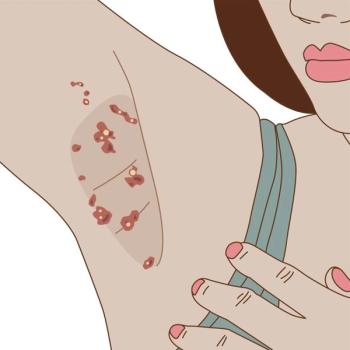
What is this mass?
A 74-year-old man with a history of diabetes mellitus, atrial fibrillation, and stroke had a stable, skin-colored mass on his upper back for the past 10 years that had suddenly become swollen and red.
Select your Dx below and see how your colleagues voted. (
ANSWER: Inflamed Epidermal Inclusion Cyst
The patient was afebrile and had no associated symptoms. The white blood cell count was normal. Gram stain showed only epithelial cells. Culture results were negative. A 10-day course of antibiotic therapy was prescribed; however, the lesion spontaneously erupted and completely subsided the next day.
Epidermal cysts may remain small and stable for years or slowly enlarge. When it becomes inflamed, it ruptures and yellow keratin with sterile purulent material drains into the dermis. A ruptured epidermal cyst is often confused with a furuncle or abscess. Other conditions in the differential diagnosis include pilar cyst, rheumatoid nodule, neurofibroma, keratoacanthoma, lipoma, and neuroma.1,2
An epidermal cyst contains keratinous material within a wall that is lined with squamous epithelium. The cysts can measure up to several centimeters and usually have an orifice, or “blackhead.” They may occur on the face, posterior auricular folds, chest, back, labia, and scrotum.1 When the lesions are numerous or located in unusual areas, such as the legs, a workup for Gardner syndrome is indicated.1,2
Treatment of a ruptured or inflamed cyst consists of incision and drainage.1 During the procedure, the cyst wall can be grasped and removed from the connective tissue. For large cysts, excision is the treatment of choice.1 Prophylactic antibiotic therapy is generally unnecessary.
References:
REFERENCES:
1.
Habif TP. Benign skin tumors. In:
Clinical Dermatology: A Color Guide to Diagnosis and Therapy
. 4th ed. New York: Mosby; 2004:698-723.
2.
Bolognia JL, Braverman IM. Skin manifestations of internal disease. In: Kasper DL, Braunwald E, Fauci AS, et al, eds.
Harrison's Principles of Internal Medicine
. 16th ed. New York: McGraw-Hill; 2005:296-311.
Newsletter
Enhance your clinical practice with the Patient Care newsletter, offering the latest evidence-based guidelines, diagnostic insights, and treatment strategies for primary care physicians.


















































































































































































































































































